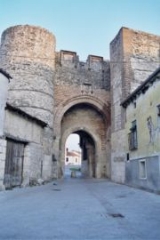
Cuéllar
Encyclopedia
Cuéllar (ˈkweʎar) is a large town and local government district in the autonomous community of Castile and León
, in Spain. It had a population of 9,841 in 2008.
The town is settled in a hill, and it is 60 km north-east from the capital city of Segovia
, and 50 km south from Valladolid
. It has an extension of 272 km² and it is 857,93 m over the sea level. Flowing in its surface are the rivers Cerquilla and Cega. To the north, the town borders the municipality of Bahabón
(province of Valladolid); to the south it borders Sanchonuño
; to the east is Frumales
; and to the west are the municipalities of San Cristóbal de Cuéllar
and Vallelado
.
Cuéllar has a long-standing agriculture
tradition. Specific crop
s are cereal
s, vegetable
s, chicory
, legumes, and beet
. Specific livestock
raised are pigs, sheep and cows. Many years ago, forestry
and resin
production were important economic resources too.
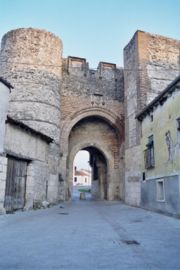 There is some evidence of scattered Iron Age
There is some evidence of scattered Iron Age
settlement in the upper area, near the castle. Roman settlements have not been discovered in the town.
(Spanish name Almanzor) sacked the town and enslaved its population, deporting them to Andalusia
. King Alfonso VI of León and Castile rebuilt the town again and brought new settlers at the end of the 11th century. This was the origin of the municipality, ruled by its town council. In 1184, king Alfonso VIII of Castile
assembled the parliament in Cuéllar; there, he granted knighthood to several noblemen and among of them was the Count of Tolosa.
In the 13th century, Cuéllar was one of the most important towns in the north of Spain. The wool trade enriched the local economy. Many palaces and Mudéjar
churches were built. In 1256, Alfonso X of Castile
granted Cuéllar with a Royal Fuero
(special law with privileges). Queen Maria de Molina, Sancho IV of Castile
's wife, inherited the town after the death of her husband. The town was a safety place during her difficult regency while future King Ferdinand IV of Castile
was a child.
In the middle of the 14th century, King Pedro I 'the Cruel' married doña Juana de Castro in Cuéllar. The marriage was a fraud because the King was divorced from his former wife in an unlawful way, and because he deserted doña Juana after their wedding night.
In 1464, King Henry IV of Castile
gave the town as a Lordship to his favorite nobleman Beltrán de La Cueva
, first Duke of Alburquerque
. Since then, the town was bounded to this family. His great-grandson was raised to Marquess.
 In the 17th century, the town suffered a recession, along with many cities and villages in the country. The monarchy moved to Madrid
In the 17th century, the town suffered a recession, along with many cities and villages in the country. The monarchy moved to Madrid
and settled the court there, so the aristocracy also moved there. Also, it was a period of poverty because of the decadence of the wool trade, the taxes to pay the wars, and the plagues.
In the 18th century, thanks to the laws ruled by Charles III
, the town recovered some of its social and economic prosperity.
When Napoleon invaded Spain, the town was looted by the French troops, who stole all the treasuries from the churches, monasteries and the castle.
In 1833, the writer and politician Jose de Espronceda
was exiled to Cuéllar because of its liberalism ideology. He wrote the novel Sancho Saldaña or the Castilian from Cuéllar when he was living near the church of Santo Tomé.
patients and a jail for criminals. Now it is a high school and tourism center.
Due to the agriculture activities, the people of Cuéllar suffered less troubles after the civil war and did not emigrate as much as other people in the region.
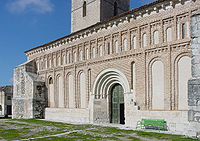
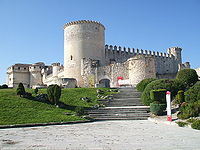
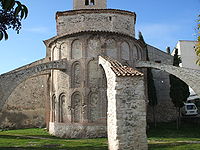


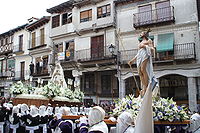
Castile and León
Castile and León is an autonomous community in north-western Spain. It was so constituted in 1983 and it comprises the historical regions of León and Old Castile...
, in Spain. It had a population of 9,841 in 2008.
The town is settled in a hill, and it is 60 km north-east from the capital city of Segovia
Segovia
Segovia is a city in Spain, the capital of Segovia Province in the autonomous community of Castile and León. It is situated north of Madrid, 30 minutes by high speed train. The municipality counts some 55,500 inhabitants.-Etymology:...
, and 50 km south from Valladolid
Valladolid
Valladolid is a historic city and municipality in north-central Spain, situated at the confluence of the Pisuerga and Esgueva rivers, and located within three wine-making regions: Ribera del Duero, Rueda and Cigales...
. It has an extension of 272 km² and it is 857,93 m over the sea level. Flowing in its surface are the rivers Cerquilla and Cega. To the north, the town borders the municipality of Bahabón
Bahabón
Bahabón, a small village and municipality in the province of Valladolid, Spain. It has a population of 198 and an area of 20.87 km²....
(province of Valladolid); to the south it borders Sanchonuño
Sanchonuño
Sanchonuño is a municipality located in the province of Segovia, Castile and León, Spain. According to the 2004 census , the municipality has a population of 824 inhabitants....
; to the east is Frumales
Frumales
Frumales is a small village in the province of Segovia, Spain. It has a population of 180 and covers an area of 28 km².Its main attractions are the Cerquilla River and the Giant Old Elm....
; and to the west are the municipalities of San Cristóbal de Cuéllar
San Cristóbal de Cuéllar
San Cristóbal de Cuéllar is a municipality located in the province of Segovia, Castile and León, Spain. According to the 2004 census , the municipality has a population of 203 inhabitants....
and Vallelado
Vallelado
Vallelado is a municipality located in the province of Segovia, Castile and León, Spain. According to the 2004 census , the municipality has a population of 831 inhabitants....
.
Cuéllar has a long-standing agriculture
Agriculture
Agriculture is the cultivation of animals, plants, fungi and other life forms for food, fiber, and other products used to sustain life. Agriculture was the key implement in the rise of sedentary human civilization, whereby farming of domesticated species created food surpluses that nurtured the...
tradition. Specific crop
Crop
Crop may refer to:* Crop, a plant grown and harvested for agricultural use* Crop , part of the alimentary tract of some animals* Crop , a modified whip used in horseback riding or disciplining humans...
s are cereal
Cereal
Cereals are grasses cultivated for the edible components of their grain , composed of the endosperm, germ, and bran...
s, vegetable
Vegetable
The noun vegetable usually means an edible plant or part of a plant other than a sweet fruit or seed. This typically means the leaf, stem, or root of a plant....
s, chicory
Chicory
Common chicory, Cichorium intybus, is a somewhat woody, perennial herbaceous plant usually with bright blue flowers, rarely white or pink. Various varieties are cultivated for salad leaves, chicons , or for roots , which are baked, ground, and used as a coffee substitute and additive. It is also...
, legumes, and beet
Beet
The beet is a plant in the Chenopodiaceae family which is now included in Amaranthaceae family. It is best known in its numerous cultivated varieties, the most well known of which is the purple root vegetable known as the beetroot or garden beet...
. Specific livestock
Livestock
Livestock refers to one or more domesticated animals raised in an agricultural setting to produce commodities such as food, fiber and labor. The term "livestock" as used in this article does not include poultry or farmed fish; however the inclusion of these, especially poultry, within the meaning...
raised are pigs, sheep and cows. Many years ago, forestry
Forestry
Forestry is the interdisciplinary profession embracing the science, art, and craft of creating, managing, using, and conserving forests and associated resources in a sustainable manner to meet desired goals, needs, and values for human benefit. Forestry is practiced in plantations and natural stands...
and resin
Resin
Resin in the most specific use of the term is a hydrocarbon secretion of many plants, particularly coniferous trees. Resins are valued for their chemical properties and associated uses, such as the production of varnishes, adhesives, and food glazing agents; as an important source of raw materials...
production were important economic resources too.
History

Iron Age
The Iron Age is the archaeological period generally occurring after the Bronze Age, marked by the prevalent use of iron. The early period of the age is characterized by the widespread use of iron or steel. The adoption of such material coincided with other changes in society, including differing...
settlement in the upper area, near the castle. Roman settlements have not been discovered in the town.
Medieval Age
Professor Ubieto Arteta showed that there is some historical evidence of Cuéllar in the 10th century. Al-Mansur Ibn Abi AamirAl-Mansur Ibn Abi Aamir
Abu Aamir Muhammad Ibn Abdullah Ibn Abi Aamir, Al-Hajib Al-Mansur , better known as Almanzor, was the de facto ruler of Muslim Al-Andalus in the late 10th to early 11th centuries. His rule marked the peak of power for Moorish Iberia.-Origins:He was born Muhammad Ibn Abi Aamir, into a noble Arab...
(Spanish name Almanzor) sacked the town and enslaved its population, deporting them to Andalusia
Andalusia
Andalusia is the most populous and the second largest in area of the autonomous communities of Spain. The Andalusian autonomous community is officially recognised as a nationality of Spain. The territory is divided into eight provinces: Huelva, Seville, Cádiz, Córdoba, Málaga, Jaén, Granada and...
. King Alfonso VI of León and Castile rebuilt the town again and brought new settlers at the end of the 11th century. This was the origin of the municipality, ruled by its town council. In 1184, king Alfonso VIII of Castile
Alfonso VIII of Castile
Alfonso VIII , called the Noble or el de las Navas, was the King of Castile from 1158 to his death and King of Toledo. He is most remembered for his part in the Reconquista and the downfall of the Almohad Caliphate...
assembled the parliament in Cuéllar; there, he granted knighthood to several noblemen and among of them was the Count of Tolosa.
In the 13th century, Cuéllar was one of the most important towns in the north of Spain. The wool trade enriched the local economy. Many palaces and Mudéjar
Mudéjar
Mudéjar is the name given to individual Moors or Muslims of Al-Andalus who remained in Iberia after the Christian Reconquista but were not converted to Christianity...
churches were built. In 1256, Alfonso X of Castile
Alfonso X of Castile
Alfonso X was a Castilian monarch who ruled as the King of Castile, León and Galicia from 1252 until his death...
granted Cuéllar with a Royal Fuero
Fuero
Fuero , Furs , Foro and Foru is a Spanish legal term and concept.The word comes from Latin forum, an open space used as market, tribunal and meeting place...
(special law with privileges). Queen Maria de Molina, Sancho IV of Castile
Sancho IV of Castile
Sancho IV the Brave was the King of Castile, León and Galicia from 1284 to his death. He was the second son of Alfonso X and Yolanda, daughter of James I of Aragon.-Biography:...
's wife, inherited the town after the death of her husband. The town was a safety place during her difficult regency while future King Ferdinand IV of Castile
Ferdinand IV of Castile
Ferdinand IV, El Emplazado or "the Summoned," was a king of Castile and León and Galicia...
was a child.
In the middle of the 14th century, King Pedro I 'the Cruel' married doña Juana de Castro in Cuéllar. The marriage was a fraud because the King was divorced from his former wife in an unlawful way, and because he deserted doña Juana after their wedding night.
In 1464, King Henry IV of Castile
Henry IV of Castile
Henry IV , King of the Crown of Castile, nicknamed the Impotent , was the last of the weak late medieval kings of Castile...
gave the town as a Lordship to his favorite nobleman Beltrán de La Cueva
Beltrán de la Cueva
Beltrán de la Cueva y Alfonso de Mercado, 1st Duke of Alburquerque was a Spanish nobleman and presumed lover of Queen Joan of Portugal.-Early life:...
, first Duke of Alburquerque
Duke of Alburquerque
For the Portuguese title: see Duke of Albuquerque .For the Spanish title: Duke of Alburquerque may refer to:*Beltrán de la Cueva, 1st Duke of Alburquerque*Francisco Fernández de la Cueva, 2nd Duke of Alburquerque...
. Since then, the town was bounded to this family. His great-grandson was raised to Marquess.
Modern Age

Madrid
Madrid is the capital and largest city of Spain. The population of the city is roughly 3.3 million and the entire population of the Madrid metropolitan area is calculated to be 6.271 million. It is the third largest city in the European Union, after London and Berlin, and its metropolitan...
and settled the court there, so the aristocracy also moved there. Also, it was a period of poverty because of the decadence of the wool trade, the taxes to pay the wars, and the plagues.
In the 18th century, thanks to the laws ruled by Charles III
Charles III of Spain
Charles III was the King of Spain and the Spanish Indies from 1759 to 1788. He was the eldest son of Philip V of Spain and his second wife, the Princess Elisabeth Farnese...
, the town recovered some of its social and economic prosperity.
When Napoleon invaded Spain, the town was looted by the French troops, who stole all the treasuries from the churches, monasteries and the castle.
In 1833, the writer and politician Jose de Espronceda
José de Espronceda
José Ignacio Javier Oriol Encarnación de Espronceda y Delgado was a famous Romantic Spanish poet.-Life:Espronceda was born in Almendralejo, at the Province of Badajoz. As a youth, he studied at the Colegio San Mateo at Madrid, having as teacher Alberto Lista...
was exiled to Cuéllar because of its liberalism ideology. He wrote the novel Sancho Saldaña or the Castilian from Cuéllar when he was living near the church of Santo Tomé.
20th century
During the civil war, the town remained part of the country controlled by the nationalist forces so its churches were preserved from the destruction. The castle served as headquarters to the fascist Italian troops, and later as a prison for prisoners. Many years after, the castle was a hospital for consumptionTuberculosis
Tuberculosis, MTB, or TB is a common, and in many cases lethal, infectious disease caused by various strains of mycobacteria, usually Mycobacterium tuberculosis. Tuberculosis usually attacks the lungs but can also affect other parts of the body...
patients and a jail for criminals. Now it is a high school and tourism center.
Due to the agriculture activities, the people of Cuéllar suffered less troubles after the civil war and did not emigrate as much as other people in the region.
Well-known people from Cuéllar
- Diego Velázquez de CuéllarDiego Velázquez de CuéllarDiego Velázquez de Cuéllar was a Spanish conquistador. He conquered and governed Cuba on behalf of Spain.-Early life:...
, Spanish conquistadorConquistadorConquistadors were Spanish soldiers, explorers, and adventurers who brought much of the Americas under the control of Spain in the 15th to 16th centuries, following Europe's discovery of the New World by Christopher Columbus in 1492...
. - Juan de GrijalvaJuan de GrijalvaJuan de Grijalva was a Spanish conquistador. Some authors said he was from the same family as Diego Velázquez.He went to Hispaniola in 1508 and to Cuba in 1511....
, Spanish conquistadorConquistadorConquistadors were Spanish soldiers, explorers, and adventurers who brought much of the Americas under the control of Spain in the 15th to 16th centuries, following Europe's discovery of the New World by Christopher Columbus in 1492...
. Some authors said he was from the same family as Diego Velázquez. - Antonio de Herrera y TordesillasAntonio de Herrera y TordesillasAntonio de Herrera y Tordesillas , Spanish historian, was born at Cuéllar, in the province of Segovia.-Biography:His father, Roderigo de Tordesillas, and his mother, Agnes de Herrera, were both of good family...
, Spanish historian during the reigns of Philip II, Philip III and Philip IV. - Gómez González de Cuéllar, deacon and founder of the Magdalena Hospital and a charity school in the 15th century.
- "Pipe" Gómez, professional cyclist racer.
Architecture





- San Martín Church (Iglesia de San Martín): It is a church built in the mudéjarMudéjarMudéjar is the name given to individual Moors or Muslims of Al-Andalus who remained in Iberia after the Christian Reconquista but were not converted to Christianity...
stile in the 14th century. It is located near the Dukes´ of Alburquerque castle. In 1997 a Center for the interpretation of the Art Mudéjar was opened inside. - San Andrés Church (Iglesia de San Andrés): There is historical evidence of its existence since 1277. It stood outside the walls of the town. It is considered as one of the most beautiful mudéjar churches in Spain.
- San Esteban Church (Iglesia de San Esteban): It stood between the first and second lines of the town walls. It is documented since 1247. Its apseApseIn architecture, the apse is a semicircular recess covered with a hemispherical vault or semi-dome...
is representative of the golden age of the mudéjarMudéjarMudéjar is the name given to individual Moors or Muslims of Al-Andalus who remained in Iberia after the Christian Reconquista but were not converted to Christianity...
art. An ancient burial ground was discovered next to it. - Santiago Church (Iglesia de Santiago): The abse is the only part of this mudéjar church that stands so far. The temple is documented since 1244. The records of the House of the Town Lineages, founded in the 14th century, were kept here.
- San Pedro Old Church (Antigua Iglesia de San Pedro): Dated since 1095, it was built in the south side of the walls. Its shape reminds a fortress. Some gothic structures remain in its tower and inside. It had to be sold by order of the civil government in the 19th century. It was used as a flour factory for many years. Nowadays it continues being a private property.
- Walls: They were built in the medieval age, around the 12th century. They were enlarged and rebuilt in the 14th and 15th centuries for defense. They are made of stone and lime. There are some arches along them. They have two different parts: one for the ancient citadel and an outer wall. They do not remain unbroken any longer because of the growth of the town, but there are several well-preserved sections besides the arches. They were declared national heritage site in 1931.
- Dukes of Alburquerque's Castle: The ancient fortress was built before the 11th century, though the current building was built in the XIV and 15th centuries, being named as castle in 1306. It is located in the top of a hill. It was restored to be a high school.
- Old school of Grammar : Charity institution founded by deacon Gómez González in 1424. It is believed that Cardinal Cisneros visited the school, but it is unknown if he was a student or a teacher. The renaissance facade remains.
- Pedro's I the Cruel Palace : Gothic palace built in the 14th century. Here, the king celebrated after getting married to doña Juana de Castro in San Martin Church in 1353.
- Magdalena Hospital: Gothic building founded in 1429 by deacon Gómez González, too. It was a charity hospital.
- San Francisco Park: This nice park is surrounded by three old cloisters: Santa Isabel o Santa Ana, San Francisco, and The Immaculate Conception. Santa Isabel is expected to be restored. San Francisco was once the biggest temple in Cuéllar. It had the Duke's of Alburquerque tombs (they are in The Hispanic Society of AmericaThe Hispanic Society of AmericaThe Hispanic Society of America is a museum of Spanish, Portuguese, and Latin American art and artifacts, as well as a rare books and manuscripts research library. Founded in 1904 by Archer M...
museum now). It had to be sold by order of the civil government and suffered a fire later; the building was nearly destroyed. Now it is used as Center for the Running of the Bulls. The Immaculate Conception was built following the BaroqueBaroqueThe Baroque is a period and the style that used exaggerated motion and clear, easily interpreted detail to produce drama, tension, exuberance, and grandeur in sculpture, painting, literature, dance, and music...
style. Currently, nuns continue living in it. - El Salvador Church: It has a Mudéjar apse with flying buttress, that gives its singular shape.
- Santa Clara Cloister: It has a renaissance facade and was one of the first gothic temples built in Cuéllar. Nuns have been living here since the 13th century.
- Santa Maria in The Hill Church: Its elegant tower can be view from many places. It is believed it was built by the TemplersTemplersTemplers, the plural of Templer, describes more than one article* Templers, South Australia is a town in South Australia* Templers are members of the Temple Society...
, however there is no evidence. - Santa Marina Tower: It was part of a former mudéjar church and made of brick.
- Santo Tomé Church: Small gothic shrine.
- San Miguel Church: It is located in the square of the town hall. It shows a mix of different building styles, and has a gothic dome inside. It keeps a sculpture of Our Lady of the Rosary, religious sponsor of the town.
- The yard in the town hall: Small yard built in renaissance style.
- Ancient Trinity Cloister: It is regretfully in ruinous condition.
Festivals

- Child's day: It is celebrated on New Year's Day. This is an old tradition, consisting in a procession centered in the Child of The Ball. The child is accompanied by musicians and dancers, and all are dressed in the 15th century clothes. They march through the town and many people use to join them.
- Running of the bulls: This festival is considered the oldest in Spain. It was dated since 1215, when a request was written to forbid priests to run with the bulls, but it is believed that the pagan tradition started before the ChristianityChristianityChristianity is a monotheistic religion based on the life and teachings of Jesus as presented in canonical gospels and other New Testament writings...
. They are celebrated for 5 days, beginning on the last Saturday evening of August, and they honor Our Lady of the RosaryOur Lady of the RosaryOur Lady of the Rosary is a title of the Blessed Virgin Mary in relation to the rosary....
. Early in the morning, the bulls run from the corral near the river 5 km away to the bull-ring. They are guided by horsemen when they are in the pine-forest, and by the people when they arrive to town. Parties and celebrations join the running when people from everywhere enjoy the traditional dishes of roasted lamb and the regional wines.
- Annual Pilgrimage to the sanctuary of Our Lady of the Hayfield (Nuestra Señora del Henar): Every the 17th September the devout people from the area go together to pray and to celebrate. This sanctuary is 5 km away from Cuéllar and it is a popular leisure place too.

